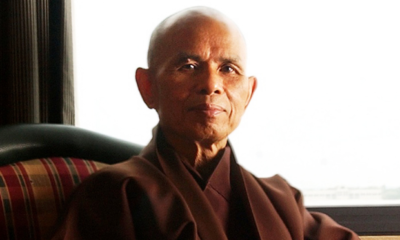Life
How to Embrace the Darkness to Hold More Light
In order to hold more light, one must be unafraid to experience more darkness

A recent New Moon meditation brought up a deep insight into the relationship between light and darkness. These concepts may appear to be esoteric and unrelated to reinvention and growth but it’s not.
After the meditation a thought came to me; “In order to hold more light, one must be unafraid to experience more darkness”.
Fearing the (flying) light
In my homeland of Curaçao, fireflies are a rarity, unlike all the ones I saw in Costa Rica at the age of six while on vacation with my family. Once, while playing late at the playground near the jungle the fireflies emerged.
Triggering an overwhelming fear within me. I ran to our room and avoided the jungle’s darkness from that day on. I had no idea what the flying lights were and they scared me shitless.
During the meditation, I was led to think of fireflies in the usual way I would think about them today; as magical harmless creatures that light up the sky. Which is the opposite of how I thought about them at six years old.
To see fireflies, it needs to be dark. The darker it is, the easier it is to see them. But how does this philosophy translate into practical terms? How can we integrate this principle into our pursuit of goals and purpose?
Easy, this philosophy urges us to recognize that setbacks, failures, and discomfort are not detours but integral components of our journey. Just as success coexists with challenges, it’s crucial to make space for both ends of the spectrum.
Success and its challenges
There’s a proverb in Dutch that translates to “Tall trees catch more wind”. Tall trees that rise above the rest are exposed to more elements, including wind. So it is with high-ranking successful people.
They are more susceptible to challenges, hatred, opposition, and failure. In contrast, not pursuing success and growth means staying in one’s comfort zone.
We all know that to succeed one needs to be comfortable being uncomfortable. However, most people are unaware that this is what’s holding them back.
They’re so used to avoiding and pushing through their feelings. Especially if it means dealing with “negative emotions”. Their fear of the darkness is what holds them back from experiencing the light that they’re craving.
At the same time, sometimes we’re afraid of the light. Like my experience with fireflies in Costa Rica. I wasn’t afraid of the darkness, just the weird flying lights. The fear of success and the fear of failure are different sides of the same coin.
To experience more success and growth, one must be able to fully embrace the darkness. To dissolve the fear of the darkness. To become completely unafraid of the possible challenges that may come.
“You will fear the darkness only to the extent that you yourself are not providing light.” — Marianne Williamson
Pushing through is not the answer
Pushing through or ignoring fears, however, works counterproductive. It may work for a while but eventually, it will come back and bite you in the ass. Facing fears through mindset work works.
Understanding that fear is an emotion, that our bodies hold on to these emotions, and being able to alchemize these emotions into something positive is a next-level experience. It truly allows anyone to hold more light and be unafraid of the darkness. In essence, it allows us to expand our comfort zone.
The easy way out
We all want the easy way out. It’s easy! Not many understand how facing our emotions, makes things so much easier. That’s because it isn’t easy on the surface. We’re not taught to do it, it’s not popular and it is uncomfortable.
It’s the darkness that we need to walk through to get to the light. Sometimes with a lot of faith while there’s still no sight of the light at the end of the tunnel.
Practical tools to dissolve the fear
Emotions are stored in our body like muscle memory. Even if it’s a one-time event it can stay in the body. Especially if it’s a traumatic experience. Our bodies hold on to emotions like this to protect us from experiencing uncomfortable feelings.
To release what’s in the body, Somatic healing modalities are necessary. Things like Breathwork, EFT Tapping, shaking, Yoga, and meditation work well. Somatic healing modalities are anything that bypasses the mind to go straight to the body.
Which not only can dissolve the fears in the body but can also activate our intuition. After all, it was a meditation that brought about the philosophy on which this entire article is based.
Being unafraid of the darkness
The dance between darkness and light is woven into the very fabric of our being. Just like fireflies casting their enchanting light into the night, we have the power to discover deep insights and inner strength when we embrace the shadows within us.
In our pursuit of bigger goals, let’s keep in mind that our ability to shine brighter is tied to our courage to journey through the darkness.
Life
10 Research-Backed Steps to Create Real Change This New Year
This New Year could finally be the one where you break old patterns and create real, lasting change.

Every New Year, we make plans and set goals, but often repeat old patterns. (more…)
Life
9 Harsh Truths Every Young Man Must Face to Succeed in the Modern World
Before chasing success, every young man needs to face these 9 brutal realities shaping masculinity in the modern world.

Many young men today quietly battle depression, loneliness, and a sense of confusion about who they’re meant to be.
Some blame the lack of deep friendships or romantic relationships. Others feel lost in a digital world that often labels traditional masculinity as “toxic.”
But the truth is this: becoming a man in the modern age takes more than just surviving. It takes resilience, direction, and a willingness to grow even when no one’s watching.
Success doesn’t arrive by accident or luck. It’s built on discipline, sacrifice, and consistency.
Here are 9 harsh truths every young man should know if he wants to thrive, not just survive, in the digital age.
1. Never Use Your Illness as an Excuse
As Dr. Jordan B. Peterson often says, successful people don’t complain; they act.
Your illness, hardship, or struggle shouldn’t define your limits; it should define your motivation. Rest when you must, but always get back up and keep building your dreams. Motivation doesn’t appear magically. It comes after you take action.
Here are five key lessons I’ve learned from Dr. Peterson:
-
Learn to write clearly; clarity of thought makes you dangerous.
-
Read quality literature in your free time.
-
Nurture a strong relationship with your family.
-
Share your ideas publicly; your voice matters.
-
Become a “monster”, powerful, but disciplined enough to control it.
The best leaders and thinkers are grounded. They welcome criticism, adapt quickly, and keep moving forward no matter what.
2. You Can’t Please Everyone And That’s Okay
You don’t need a crowd of people to feel fulfilled. You need a few friends who genuinely accept you for who you are.
If your circle doesn’t bring out your best, it’s okay to walk away. Solitude can be a powerful teacher. It gives you space to understand what you truly want from life. Remember, successful men aren’t people-pleasers; they’re purpose-driven.
3. You Can Control the Process, Not the Outcome
Especially in creative work, writing, business, or content creation, you control effort, not results.
You might publish two articles a day, but you can’t dictate which one will go viral. Focus on mastery, not metrics. Many great writers toiled for years in obscurity before anyone noticed them. Rejection, criticism, and indifference are all part of the path.
The best creators focus on storytelling, not applause.
4. Rejection Is Never Personal
Rejection doesn’t mean you’re unworthy. It simply means your offer, idea, or timing didn’t align.
Every successful person has faced rejection repeatedly. What separates them is persistence and perspective. They see rejection as feedback, not failure. The faster you learn that truth, the faster you’ll grow.
5. Women Value Comfort and Security
Understanding women requires maturity and empathy.
Through books, lectures, and personal growth, I’ve learned that most women desire a man who is grounded, intelligent, confident, emotionally stable, and consistent. Some want humor, others intellect, but nearly all want to feel safe and supported.
Instead of chasing attention, work on self-improvement. Build competence and confidence, and the rest will follow naturally.
6. There’s No Such Thing as Failure, Only Lessons
A powerful lesson from Neuro-Linguistic Programming: failure only exists when you stop trying.
Every mistake brings data. Every setback builds wisdom. The most successful men aren’t fearless. They’ve simply learned to act despite fear.
Be proud of your scars. They’re proof you were brave enough to try.
7. Public Speaking Is an Art Form
Public speaking is one of the most valuable and underrated skills a man can master.
It’s not about perfection; it’s about connection. The best speakers tell stories, inspire confidence, and make people feel seen. They research deeply, speak honestly, and practice relentlessly.
If you can speak well, you can lead, sell, teach, and inspire. Start small, practice at work, in class, or even in front of a mirror, and watch your confidence skyrocket.
8. Teaching Is Leadership in Disguise
Great teachers are not just knowledgeable. They’re brave, compassionate, and disciplined.
Teaching forces you to articulate what you know, and in doing so, you master it at a deeper level. Whether you’re mentoring a peer, leading a team, or sharing insights online, teaching refines your purpose.
Lifelong learners become lifelong leaders.
9. Study Human Nature to Achieve Your Dreams
One of the toughest lessons to accept: most people are self-interested.
That’s not cynicism, it’s human nature. Understanding this helps you navigate relationships, business, and communication more effectively.
Everyone has a darker side, but successful people learn to channel theirs productively into discipline, creativity, and drive.
Psychology isn’t just theory; it’s a toolkit. Learn how people think, act, and decide, and you’ll know how to lead them, influence them, and even understand yourself better.
Final Thoughts
The digital age offers endless opportunities, but only to those who are willing to take responsibility, confront discomfort, and keep improving.
Becoming a man today means embracing the hard truths most avoid.
Because at the end of the day, success isn’t about luck. It’s about who you become when life tests you the most.
Change Your Mindset
The Four Types of Happiness: Which One Are You Living In?
Most people chase success only to find emptiness, this model reveals why true happiness lies somewhere else.

In a world driven by rapid technological growth and constant competition, many people unknowingly trade joy for achievement. (more…)
Change Your Mindset
The Secret Daily Routines Behind History’s Most Brilliant Thinkers
Uncover the daily rituals and hidden habits that powered history’s most brilliant minds to success.

Why Daily Rituals Matter
Every great achiever has one thing in common: discipline. Behind the novels, inventions, discoveries, and masterpieces are small, consistent habits repeated daily. (more…)
-

 Personal Development4 weeks ago
Personal Development4 weeks agoThis Silent Habit Might Be Sabotaging Your Career
-

 Business3 weeks ago
Business3 weeks agoWhy Your E-Commerce Fulfilment Is Probably Broken (And How to Fix It)
-

 Shift Your Mindset3 weeks ago
Shift Your Mindset3 weeks ago11 E’s That Define Every Great Leader And Why Most People Miss Them
-

 Did You Know2 weeks ago
Did You Know2 weeks agoThe Success Patterns You Inherited (And Didn’t Notice)
-

 Business2 weeks ago
Business2 weeks agoThe Hidden Money Pit in Your Operations (and How to Use It)
-

 Entrepreneurs2 weeks ago
Entrepreneurs2 weeks agoThe Essential Skills Every Entrepreneur Needs In 2026
-

 Change Your Mindset1 week ago
Change Your Mindset1 week agoHow to Turn Your Mind Into Your Greatest Asset (Instead of Your Enemy)
-

 Change Your Mindset5 days ago
Change Your Mindset5 days agoThe Silent Skill That Makes People Respect You Instantly


























